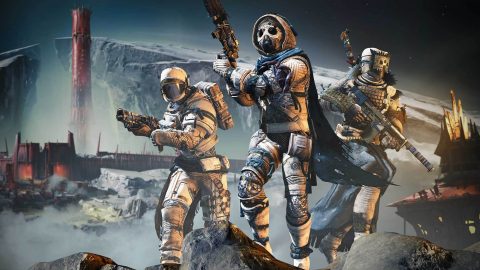
Free-to-play mobile games get a bad rap – often not without justification. Many feel cheaply made and tied in with big licenses with little impetus than to make you spend money to make any meaningful progress. But Genshin Impact doesn’t feel like your typical free-to-play game at all. Not only has it also been developed for PC and console, but it’s on a grand and wondrous scale as any full-priced game – with more than a passing resemblance to The Legend Of Zelda: Breath Of The Wild.
That’s another hurdle this game had to get over, with many assuming at first glance that this was a shameless copycat of Nintendo’s masterpiece, not helped by the fact that China, where the developer miHoYo is based, has a reputation for producing knock-offs.
There’s certainly similarities, from the lush green expanses and a glider to travel around with to the cel-shaded anime characters and a contextual score that employs the piano for its ambient moments. But almost four years later, with most AAA developers still relying on very formulaic open world game design that ushers you from plot point to plot point, Genshin Impact just feels like a developer following best practice.
The most exciting thing Genshin Impact brings to the table is its combat system. On top of the standard melee or ranged attacks, each character specialises in a different element that can drastically change gameplay. Facing an enemy with a wooden shield? Use Pyro to burn it away. When they catch on fire, why not switch to your Ameno wind-based character whose gust makes those flames spread even further? But if your foe is made of fire, then a Hydro character can douse them with water-based attacks. The environment can come to your aid, whether it’s battling enemies in the rain or near a river – being wet makes them susceptible to being frozen with Cryo or shocked with Electro attacks.
These elemental skills run on a cooldown, while ultimate burst skills needs to be charged up over time by defeating more enemies. There’s also a brief cooldown when hot-swapping characters in a party maximum of four, but the point is you can easily swap between your party members, chaining and exploiting different elements for ridiculous damage that mows down swarms of goblins or even the tougher big hitters in no time. You can really put your skills to the test – in exchange for a treasure trove of rewards, of course, by taking on dungeons or challenge posts where you have a time limit on defeating enemies.
Naturally, this is where the game’s gacha/lootbox-style monetisation first comes into play. While the starting party of characters is decent, as are the numerous interesting and attractive faces you’ll meet along the way, unlocking the rest of the playable roster requires the use of Wishes. You’re given a generous number at the start but after that you need to spend Primogems, the game’s premium currency, to unlock more. And with the most powerful five-star characters having just a 0.6 per cent drop rate, completionists who need to collect every character could find themselves spending a lot of real money.

It’s not quite as insidious as it sounds though. For example, the star ratings are for individual characters, so you’re not forced to roll multiple times to get a better version of the same character, which can often be the case in other free-to-play games. While you’ll certainly benefit from having a healer or powerful Pyro-based swordsman like Diluc, not having them won’t prevent you from progressing further in the core story. In fact, if you play character-focused quests, you’ll even have certain characters tag along as ‘guests’. In addition, miHoYo also rotates some rare characters as a free trial, such as mischievous wind mage Venti.
You can also earn Primogems from simply playing the game – one quick and easy way is by running the daily missions. While each player will approach this differently, I’ve unlocked almost half of the available characters and have ample resources to level them and their equipment up without being compelled to spend a penny.
More importantly, these mechanics don’t feel intrusive when you’re just after a good time. You do occasionally come across quests or dungeons that are beyond your Adventure Rank and there can be a grind to get to them, but there’s also no particular rush. Sure, there is a plot about your protagonist tracking down their missing twin sibling before you’re thrown into a quest to stop an out-of-control dragon spirit, all presented with big anime energy, but as one character says: “It’s about the journey.” Take your time to explore the fantastical world of Teyvat and what it has to offer, and especially Genshin Impacts’s second area, the jaw-dropping China-inspired region of Liyue.
Genshin Impact takes the most important lesson from The Legend Of Zelda: Breath Of The Wild that other open world games have yet to learn. It trusts you to seek out adventure by simply pointing the camera anywhere that catches your eye, from the top of a mountain, a deep ravine or ancient ruins. In between, you’re just as easily led astray by collecting elemental orbs used to improve your stamina, solving a puzzle or clearing an enemy camp that will almost certainly yield some treasure.
It’s just the beginning too, as the game and Teyvat’s seven nations are far from complete. miHoYo is treating Genshin Impact as a live service game, adding more content over time – a bold proposition for an open world game. Yet, it’s already got the charming aesthetics and compelling combat mechanics to carry it, compared to say the underwhelming endgame of Marvel’s Avengers. You might even say it’s a perfect fit, given its episodic quest structure.

Genshin Impact is easy to jump into, with its episodic structure preventing newcomers from being overwhelmed with content on day one, while those who want a time sink have plenty of high level dungeons to keep them on their toes. Plus, there’s potential for Genshin Impact to stay in healthy rotation for a long time, with plans for content updates every six weeks.
Ultimately, the game is neither a cheap Breath Of The Wild clone nor a mere stop gap option for its sequel, but instead it’s very much its own unique thing – one that should be relished.
‘Genshin Impact’ is out now for PlayStation 4, PC, iOS and Android.
Our Verdict
As a newly released free-to-play game, it’s currently hard to discern just how deeply Genshin Impact’s monetisation will have an impact on your wallet. But just from its opening chapter, you have a fantastic open world adventure that’s larger and more rewarding than most full-priced games. With its charming cast of characters, deliciously inspired combat and more content updates coming on a regular basis, there’s no reason why you won’t keep returning to the wonderful world of Teyvat.
Pros
- Breathtakingly beautiful to behold with a colourful roster of anime characters
- You’re never far from a treasure, puzzle, challenge, or anything that piques your curiosity
- Extremely satisfying elemental-based combat, with plenty of optional dungeons and bosses to test your skills for rewards
- Liberally takes The Legend Of Zelda: Breath Of The Wild’s best ideas while leaving out the less convenient aspects
Cons
- The drop rate for five-star characters and weapons is extremely low
The post ‘Genshin Impact’ review: it does more than just ride on the coattails of ‘Breath Of The Wild’ appeared first on NME Music News, Reviews, Videos, Galleries, Tickets and Blogs | NME.COM.










